
The Korean War was fought between North Korea and South Korea from 1950 to 1953. It began on 25 June 1950 when North Korea invaded South Korea and ceased after an armistice on 27 July 1953. The north was supported by China and the Soviet Union while the south was supported by United Nations (UN) forces led by the United States.

The Malmedy massacre trial was held in May–July 1946 in the former Dachau concentration camp to try the German Waffen-SS soldiers accused of the Malmedy massacre of 17 December 1944. The highest-ranking defendant was the former Waffen-SS general Sepp Dietrich.
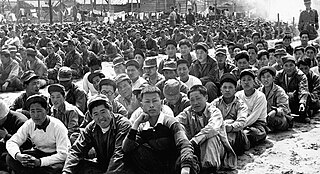
A prisoner-of-war camp is a site for the containment of enemy fighters captured as prisoners of war by a belligerent power in time of war.

The People's Volunteer Army (PVA), officially the Chinese People's Volunteers (CPV), was the armed expeditionary forces deployed by the People's Republic of China during the Korean War. Although all units in the PVA were actually transferred from the People's Liberation Army under the orders of Chairman Mao Zedong, the PVA was separately constituted in order to prevent an official war with the United States. The PVA entered Korea on 19 October 1950 and completely withdrew by October 1958. The nominal commander and political commissar of the PVA was Peng Dehuai before the ceasefire agreement in 1953, although both Chen Geng and Deng Hua served as the acting commander and commissar after April 1952 following Peng's illness. The initial units in the PVA included 38th, 39th, 40th, 42nd, 50th, 66th Corps; totalling 250,000 men. About 3 million Chinese civilian and military personnel had served in Korea throughout the war.
The Permanent Subcommittee on Investigations (PSI), stood up in March 1941 as the "Truman Committee," is the oldest subcommittee of the United States Senate Committee on Homeland Security and Governmental Affairs. After the September 11, 2001, terrorist attacks in the United States, the Committee broadened its title to Homeland Security and Governmental Affairs Committee. PSI led the Committee's broad mandate to "investigate inefficiency, mismanagement, and corruption in Government."

The Korean People's Army Air Force is the unified military aviation force of North Korea. It is the second largest branch of the Korean People's Army comprising an estimated 110,000 members. As of 2024, it is estimated to possess some 570 combat aircraft, 200 helicopters, and a few transporters, mostly of decades-old Soviet and Chinese origin. Its primary task is to defend North Korean airspace. In April 2022, the Korean People's Army Air and Anti-Air Force name was changed to Korean People's Army Air Force.

Operation Big Switch was the repatriation of all remaining prisoners of the Korean War. Ceasefire talks had been going on between the North Korean, Chinese and United Nations Command (UNC) forces since 1951, with the main point of contention being the repatriation of all prisoners to their home countries, in accordance with Article 118 of the 1949 Geneva Convention. China and North Korea wanted prisoners to be compulsorily repatriated as outlined by the Geneva Convention but the UNC insisted that prisoners who wished to remain where they were be allowed to do so. After talks dragged on for two years, the Chinese and North Koreans relented on this point, and the Korean Armistice Agreement was signed on 27 July 1953.

Australia entered the Korean War on 28 September, 1950; following the invasion of South Korea by North Korea. The war's origins began after Japan's defeat in World War II, which heralded the end to 35 years of Japanese occupation of the Korean Peninsula. The surrender of Japan to the Allied forces on 2 September 1945, led to the division of Korea into two countries, which were officially called the Democratic People's Republic of Korea (DPRK) and the Republic of Korea (ROK), with the DPRK being occupied by the Soviet Union, and the ROK, below the 38th Parallel, being occupied by the United States (US).
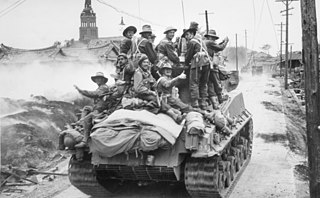
The Battle of Sariwon took place on 17 October 1950 during the United Nations (UN) counter-offensive against the North Korean forces which had invaded South Korea. With many Korean People's Army (KPA) units falling back under pressure from UN forces the 27th British Commonwealth Brigade under Brigadier Basil Coad—–comprising the 1st Battalion, the Argyll and Sutherland Highland Regiment, the 1st Battalion, the Middlesex Regiment and 3rd Battalion, the Royal Australian Regiment (3RAR) captured the town of Sariwon during a confused and largely one-sided action. Elements of the 7th US Cavalry Regiment were also involved. KPA casualties included 215 killed and more than 3,700 captured, whilst British-Commonwealth losses were 1 killed and 3 wounded.
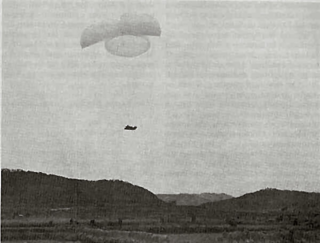
The Battle of Yongyu, also known as the Battle of the Apple Orchard or the Battle of Yongju by the Australians who fought in it, took place between 21 and 22 October 1950 during the United Nations Command (UNC) offensive into North Korea against the Korean People's Army (KPA) that had invaded South Korea during the Korean War. The battle was fought between the 3rd Battalion, Royal Australian Regiment of the 27th British Commonwealth Brigade and the KPA 239th Regiment.
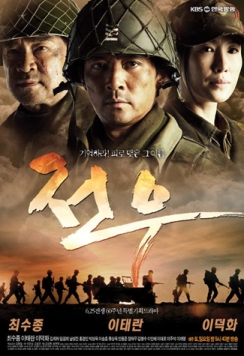
Legend of the Patriots is a remake of the 1975 South Korean drama Comrades. Its production was spawned to commemorate the 60th anniversary of the Korean War. The story centers around the lives of eleven Korean soldiers fighting in the Korean War. Director Kim Sang-hwi remarked that the series is not about the ideologies of South and North Korea, but rather focuses on the struggles of ordinary people who lived through the war.
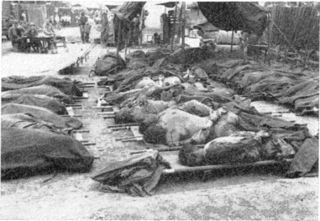
The Hill 303 massacre was a war crime that took place during the opening days of the Korean War on August 17, 1950, on a hill above Waegwan, Republic of Korea. Forty-one United States Army (US) prisoners of war were murdered by troops of the North Korean People's Army (KPA) during one of the engagements of the Battle of Pusan Perimeter.

The Chaplain–Medic massacre took place in the Korean War on July 16, 1950, on a mountain above the village of Tuman. Contrast to U.S. Army's official history, South Korean local natives claimed that it took place on a mountain above the village of Yongdam-ri, which is next to Duman-ri. Thirty unarmed, critically wounded United States Army (US) soldiers and an unarmed chaplain were murdered by members of the Korean People's Army (KPA) during the Battle of the Kum River.

The Palawan massacre occurred on 14 December 1944, during World War II, near the city of Puerto Princesa in the Philippine province of Palawan. Allied soldiers, imprisoned near the city, were killed by Imperial Japanese soldiers. Only eleven men managed to survive.
The Bloody Gulch massacre was a war crime that took place in the Korean War on August 12, 1950, in "Bloody Gulch", west of Masan, South Korea. After a successful attack on two US artillery battalions that killed or injured hundreds of US soldiers, North Korea's Korean People's Army (KPA) 13th Regiment then killed 75 US Army prisoners of war. Otherwise this was one of the smaller engagements of the Battle of Pusan Perimeter. The 75 soldiers were from the 555th Field Artillery Battalion of the US 24th Infantry Division and the 90th Field Artillery Battalion of the US 25th Infantry Division.
The South Korean government, under the regime of Park Chung Hee, took an active role in the Vietnam War. South Korea's decision to join resulted from various underlying causes, including the development of US-South Korea relations, political exigencies, and the promise of economic aid from the United States. Under the wartime alliance, the South Korean economy flourished, receiving tens of billions of dollars in grants, loans, subsidies, technology transfers, and preferential economic treatment. Under the American wartime alliance, South Korea saw economic expansion due to significant financial assistance, such as grants, loans, subsidies, technology transfers, and advantageous economic policies provided by the United States. From September 1964 to March 1973, South Korea sent some 350,000 troops to South Vietnam. The South Korean Army, Marine Corps, Navy, and Air Force all participated as an ally of the United States. The number of troops from South Korea was much greater than those from Australia and New Zealand, and second only to the U.S. military force for foreign troops located in South Vietnam. The military commander was Lieutenant General Chae Myung-shin of the South Korean army. Participation of Korean forces in the war included both non-combatant and combatant roles.
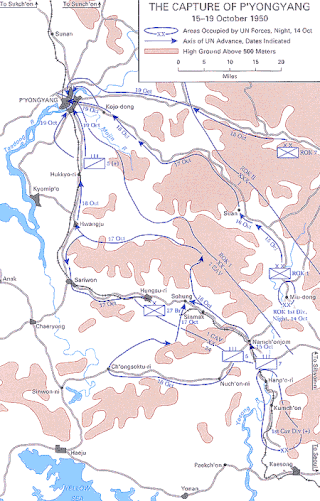
The Battle of Pyongyang was one of the major battles of the United Nations' offensive during the Korean War. Following the Battle of Inchon, the UN forces re-captured Seoul, the capital of South Korea, and proceeded to advance into North Korea. Shortly after advancing, the American and South Korean forces faced the North Korean defenses near Pyongyang, the capital of North Korea, on 17 October.
The Korean War was a major conflict of the Cold War and among the most destructive conflicts of the modern era, with approximately 3 million killed, most of whom were civilians. It resulted in the destruction of virtually all of Korea's major cities, with thousands of massacres committed by both sides—including the mass killing of tens of thousands of suspected communists by the South Korean government, and the torture and starvation of prisoners of war by the North Koreans. North Korea became among the most heavily bombed countries in history.
The UN offensive into North Korea was a large-scale offensive in late 1950 by United Nations (UN) forces against North Korean forces during the Korean War.

Remembered Prisoners of a Forgotten War: An Oral History of Korean War POWs is a 2002 military history book by Lewis H. Carlson. Using first-hand testimonies by repatriated prisoners of war of their experiences in captivity in Korea, the book demystifies the general perception in the United States that Korean War POWs had been "brainwashed" by their captors, and had betrayed their country.













